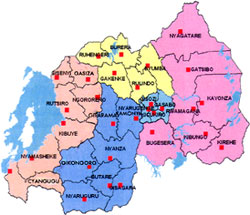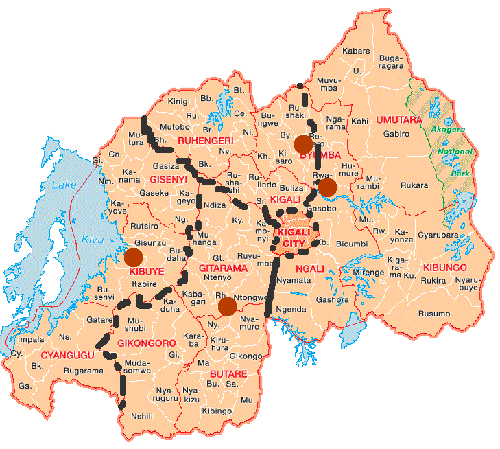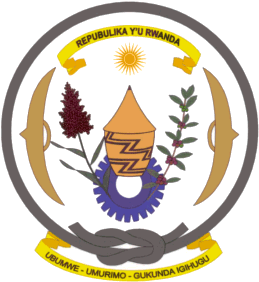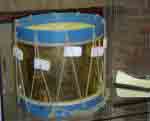Rwanda to reduce number of provinces to five
BBC
Monitoring Africa
Text of report in English by Rwandan news agency RNA
The minister of good governance, community development and
social affairs (MINALOC), Protais Musoni, has said that Rwanda is to be
divided into just five provinces, down from 12, in a government-led effort to
restructure provincial borders and frontiers, RNA has established.
While addressing reporters during a press conference at the
ministry's offices minister Musoni disclosed that the country, which was
originally divided into 12 provinces, 160 districts, 1545 sectors and 9165 cells
will be divided into only four provinces and Kigali city with 30 districts and
500 sectors.
The minister further revealed that, the names of the new
provinces are yet to be decided upon, but in the meantime they will be known as
Northern, Eastern, Western and Southern provinces, with the towns of Rwamagana
and Nyanza emerging as headquarters of the eastern and southern provinces
According to a new map available at the ministry certain areas
will also assume new names, with the new names appearing in all the five
provinces.
The minister continued to say that each sector will be
populated by 15,000 to 20,000 people, and water and electricity services will be
improved, alluding to the rampant water and electricity shortages that have
ravaged the country for over a year now.
Fielding questions from the reporters, the minister responded
by stressing that the exercise will benefit locals more than inconvenience them,
and disclosed that the action will restore order to the somewhat inefficient
grass root levels.
"Nothing can be only positive, everything has its
advantages and disadvantages, but in this case the advantages tend to outweigh
the disadvantages," the minister articulated.
He also said the refurbishing of the existing offices and
headquarters to suit the new developments will cost an estimated 3bn Rwandan
francs.
Mr. Musoni was also quoted as saying that the exercise will
improve the services offered by the districts since more workers will be
operating from one base.
The country has undergone numerous reforms including the
changing of the national anthem, flag, emblem, public reform and now the
administrative divisions.
Mwirebere namwe aho imitwe
igeze_ Hari byinshi aya makarita aduhishe
 |
Chef-lieux: Ouest- Rwamagana
Est: Kibuye
Sud: Nyanza
Nord: Byumba

|
|
Il y a un élément qui me semble capital dans les objectifs visés par
les réformes territoriales annoncées. Il s'agit d'une volonté
profonde de révisionnisme, un processus de lavage de cerveau au peuple
rwandais, pour le priver de tous les repères psycho-sociologiques
auxquels il s'est référé depuis plus de 40 ans. Dans la tête
des promoteurs des réformes, il s'agit de l'étape ultime de
l'installation du "nouveau Rwanda". Un Rwanda où toute
référence au passé des années 60-90 est diabolisé et réprimé sans
merci et avec une brutalité et une maladresse sans égales.
Loin de conclure le plan des nouveaux créateurs du Rwanda, cette démarche
constitue une véritable impasse socio-politique et ne présage aucun
avenir paisible pour le Rwanda. C'est une provocation de trop et
une preuve supplémentaire que les priorités du régime sont fortement
décalés par rapport aux besoins primordiaux d'une population
abandonnée à elle seule. Dans un pays où la population fait
face quotidiennement aux besoins de survie, la prédisposition du régime
à privilégier des chambardements territoriaux démontre à suffisance
que ce régime a d'autres chats à fouetter que de s'occuper du dévelloppement
intégré du pays. C'est un régime dont les préoccupations
essentielles visent à distraire la communauté internationale qui traîne
trop à découvrir le caractère anti-national du projet de société véhiculé
par le régime d'occupation du FPR. Il va sans dire qu'un tel régime
ne prévoit aucun espace pour la libre expression des libertés
publiques.
Commentaires de:
Joseph Ndahimana.
|
|
Provincial demarcations cause fear
among MPs
|
|
|
|
| By
James Munyaneza |
| Thursday, 04
August 2005 |
|
The impending fresh demarcations of Rwanda's administrative
territories, approved last week by the Cabinet, have caused
uproar in both chambers of parliament as several MPs fear
losing their jobs. Instead of eleven provinces and Kigali City
as it is presently, MINALOC is proposing reducing them to five
provinces.
|
|
|
Last Wednesday, senators asked Local
Government and Social Affairs Minister Protais Musoni to allay
their fears about the likely negative consequences that some
Senators and MPs might face once the reforms come into force.
The Minister was presenting the proposed local government
territories to be effected January 2006.
|
|
They expressed concern particularly on the fate of
those senators and deputies that came into parliament during the 2003
parliamentary elections representing the current provinces and Kigali
city. It was an apparent reference to twelve senators, each
representing a province, one from Kigali city, and twenty six women in
the Chamber of Deputies, each of the present eleven provinces and
Kigali city having two.
"I am wondering what would be the fate of those MPs who represent
different constituencies once these areas are re-demarcated,"
Senator Dr Odette Nyiramirimo (PL) queried. Senator Chrysologue
Kubwimana (Gisenyi) and others voiced the same concerns.
However in response, Minister Musoni could not satisfactorily put to
rest the MPs' anxiety as he said no definite agreement had been
reached yet on most of the looming impacts of the reforms. But he told
MPs that his suggestion would be that they retain their seats only
during the current mandate and then the Constitution be reviewed and
adjusted accordingly.
"For instance where the Constitution says 'each province shall
have two (women) MPs' provision can be modified say on the number of
representations to reflect the new arrangement," Musoni said. He
said this would however be debated on and a final decision taken.
"It is thereafter, that elections would be organised in
accordance with the new demarcations," he added.
Should the executive and legislature accommodate Musoni's proposal,
then the reforms would most likely hurt the 24 women MPs representing
the Constituencies than the affected senators. This is because
deputies would remain uncertain whether to vie for a second term in
2007 when their five-year mandate ends, while senators are to serve an
eight-year non renewable term.
But it remains to be seen what would befall these legislators should
Musoni's proposals sail through.
Some political pundits however say that even with the second
possibility, the affected legislators could still retain their posts
by virtue of Article 64 (A) in the Constitution. It reads, "Every
Member of Parliament represents the whole nation and not just those
who elected or nominated him or her or the political organisation on
whose ticket he or she stood for election."
Senators looked slightly excited at the new public and territorial
administrative redesigns, but the uncertainty over the fate of the
seats saw an apprehensive atmosphere marring the plenary session.
They also expressed anxiety over the impending loss of jobs by
thousands of civil servants at local government levels as a result of
the reforms. They also questioned the names to be given to the new
areas. On this, Musoni said most of the areas would be named after
their respective present towns to avoid the difficulties that were
encountered during the previous naming of areas which almost split the
then Transitional National Assembly into two.
The minister said the proposed setup establishes districts widely on
the model of the past arrangement of Sous Prefectures, and said the
new district authorities will have full powers to use infrastructures
that formerly belonged to the Sous-Prefectures.
Reforms
Under the new arrangement, provinces have been condensed from eleven
down to four. Kigali City has also been stretched to several areas
currently belonging to Kigali-Ngali Province.
The proposed districts are 30, a remarkable fall from 106 today, while
sectors would be cut from the current 1,545 to about 450.
Kigali city is planned to have four districts down from eight. The
proposed districts, each a merger of several districts, are Nyarugenge,
Gisozi, Kicukiro and Gasabo. This means that under the new proposal,
the districts of Kacyiru, Kanombe, Gikondo, Nyamirambo and Butamwa
would cease to exist.
The rest of the country will be divided into four larger provinces:
Eastern, Northern, Western and Southern. The Eastern province will
cover today's provinces of Umutara, Kibungo and some parts of
Byumba and Kigali-Ngali provinces; while several districts of Byumba,
Kigali-Ngali and Ruhengeri will be merged to form the Northern region.
The Western region will comprise of the present-day provinces of
Gisenyi, Kibuye and Cyangugu and parts of Ruhengeri province; while
the Southern region would merge the provinces of Gitarama, Butare,
Gikongoro, Kibuye and some areas of Kigali Ngali province.
Proposed provincial districts and Capitals:
East- Bugesera, Gatsibo, Kayonza, Kibungo, Kirehe,
Rwamagana (capital)
and Nyagatare.
North-Burera,
Byumba (capital), Gakenke, Ruhengeri and Rulindo.
West-Cyangugu, Gasiza, Gisenyi,
Kibuye (capital), Ngororero,
Nyamasheke and Rutsiro.
South-Butare, Gikongoro, Gisagara, Gitarama, Kamonyi,
Nyanza (Capital)
and Nyaruguru.
|
Comme le disait si pertinemment notre Gacamigani national, "INKA
YA NKORONKO IGIRA INKOMOKO".
Rien (mais alors absolument rien) chez les INKOTANYI ne se fait au hasard; et
surtout pas le choix des noms, des lieux et des symboles.
La liste des capitales du Rwanda sous Kigeri IV Rwabugiri rwa Nkoronko
et sous Kagame 1er ka Rutagambwa est très éloquente et se passe de tout
commentaire.
I. Les capitales du Rwanda sous Kigeri IV Rwabugiri rwa Nkoronko
dit INKOTANYI CYANE étaient:
1.
KIGALI (umurwa mukuru) ou, en cas d'oracles divinatoires défavorables,
Kabuye près Jabana toujours à KIGALI;
2. Mwima près Mushirarungu à NYANZA;
3. Rubengera à KIBUYE;
4. Gatsibo à BYUMBA ou, en cas d'oracles divinatoires défavorables,
Nyabishambi toujours à BYUMBA;
5. Gasabo dans le Buganza, ou, en cas d'oracles divinatoires défavorables,
RWAMAGANA toujours dans le Buganza, RWAMAGANA.
II. Les capitales du Rwanda sous Kagame 1er ka Rutagambwa
dit INKOTANYI CYANE MZEE KIJANA sont (d'après le projet de réforme
"administrative" Protais Musoni):
1. KIGALI city;
2. NYANZA;
3. KIBUYE;
4. BYUMBA;
5. RWAMAGANA.
Les paroles prophétiques du Docteur Déogratias Munyambuga, dit Malumba (UMURIRI)
prennent aujourd'hui, de manière dramatique, toute leur signification.
BITWAJE YA
 |
NGOYI  |
BAGARUYE YA
NGOMA.
Ils n'ont manifestement rien appris ni rien oublié. Faudra-t-il une nouvelle
révolution pour qu'ils reviennent à la raison?
Objectif: Gagner les élections présidentielles
de 2010.
Condition: Gagner les élections communales de
2006.
Timing: La réforme doit être adoptée avant
2006.
Pourquoi les élections communales de 2006 sont-elles d'une importance
capitale?
Parce qu'elles détermineront le vainqueur des élections présidentielles
de 2010. Il est donc impératif que les 30 maires de districts soient tous
issus du FPR.
Qu'est-ce qui peut nous garantir que les 30 maires de districts qui seront
élus en 2006 seront tous issus du FPR?
Réponse: Le Préfet veillera au grain.
Question: Puisque les 30 maires de districts qui
seront élus en 2006 seront tous issus du FPR, ne peut-on se passer des
services du Préfet dès 2006?
Réponse: NON. Tout d'abord, on ne peut se passer
des services du Préfet avant qu'il ne fasse élire nos 30 maires.
Ensuite, même après l'élection de ceux-ci, il convient de ne pas perdre
de vue qu'une autorité nommée est toujours plus facile à contrôler
qu'une autorité élue. Les élus peuvent parfois réserver de mauvaises
surprises à ceux qui les ont fait élire. Par contre, les nommés sont
toujours fidèles. Et si d'aventure ils ne le sont plus, on les vire et on
les remplace. Il nous faut donc absolument un Préfet (ou Gouverneur,
comme on voudra l'appeler) nommé, très puissant, qui reste en place au
moins jusqu'en 2010. Cela nous évitera de mauvaises surprises d'ici là.
Question: Et que se passera-t-il en 2010?
Réponse: En 2010, commencera le second septennat
(et en principe le dernier) du Président Paul Kagame. Pour ce motif, 2017
c'est l'inconnu total. Qui peut prévoir l'inconnu? Tout peut arriver en
2017, en ce y compris une révision constitutionnelle à la Kaguta
Museveni.
De toute façon, on aura le temps d'y penser, et de voir venir. La priorité
pour le moment c'est 2010, et non 2017. Tout le reste, c'est de la poudre
aux yeux.
************************************
Abatabizi
bicwa no kutabimenya.
************************************
NIKOZITAMBIRWA, 11-08-2005.





